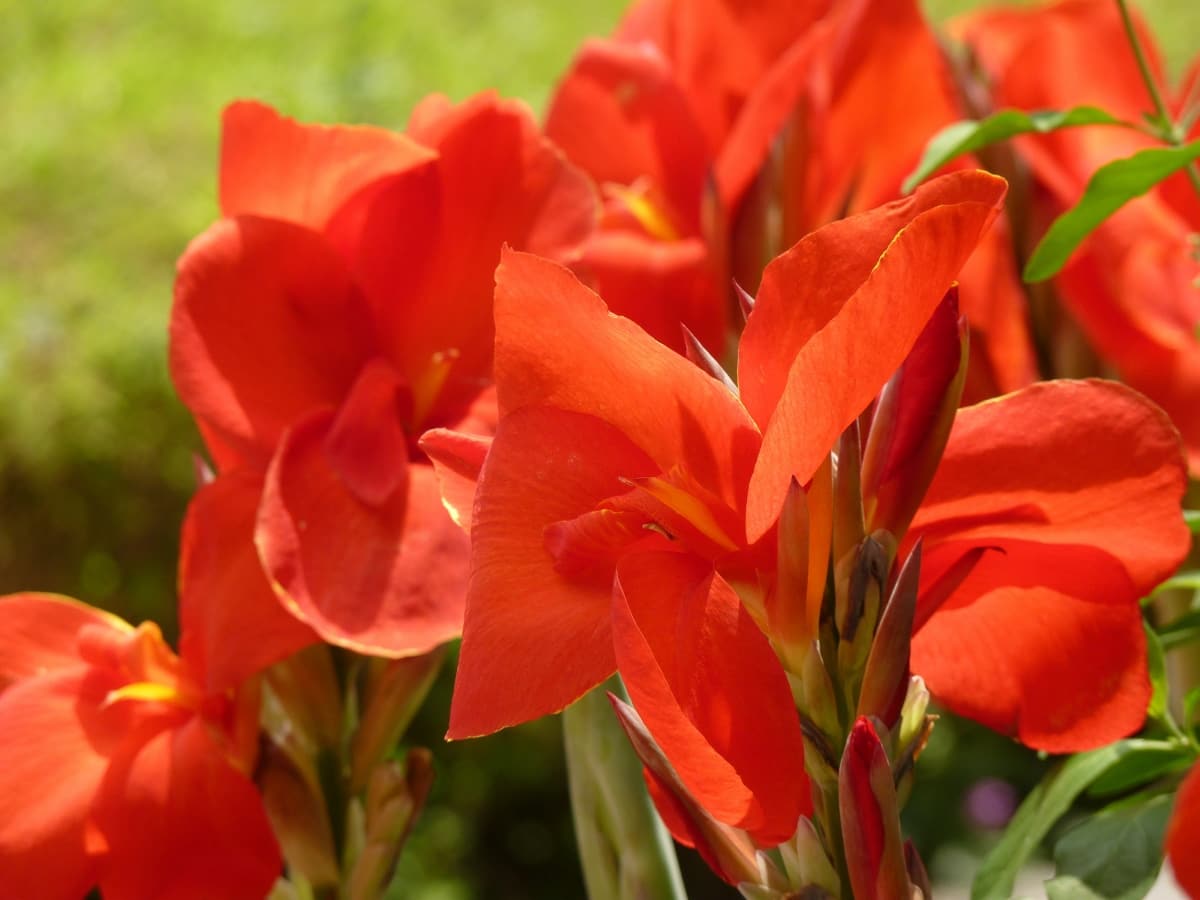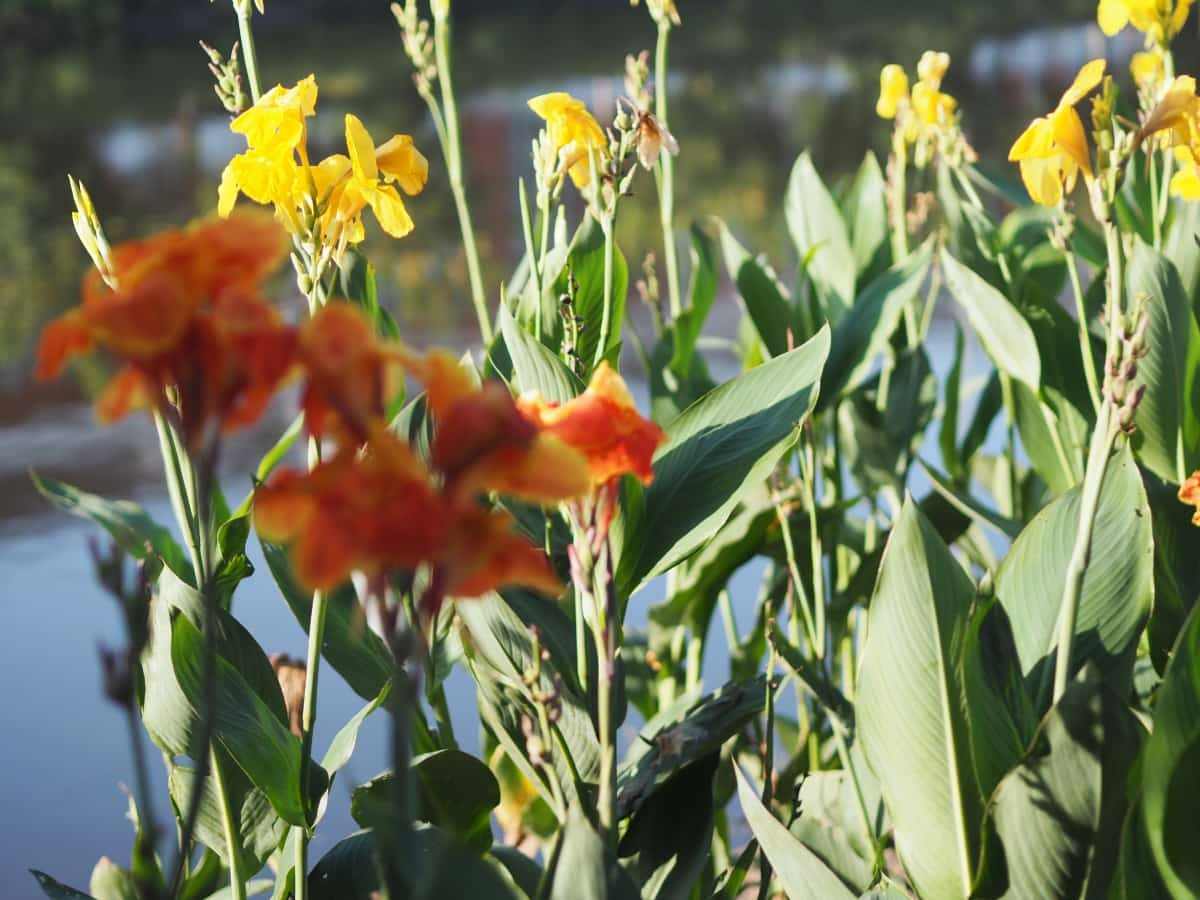Cannas are large plants that add tropical texture to a garden, whether growing in containers or planted directly in the ground. Canna is the only genus of flowering plants in the family that belongs to Cannaceae, consisting of 10 species. These are a beautiful addition to any garden, with their vibrant colors and lush foliage.

How to Plant and Care for Canna
Choosing the Right Soil and Location for Planting Canna Flowers
Cannas prefer moist soil with good drainage. The ideal pH level for Canna plants is 6.0-6.5, which means slightly acidic soil rich in organic matter. Ensure your planting area has adequate drainage because waterlogged soil can lead to root rot.
If unsure about your garden’s soil quality, consider mixing in compost or other organic matter before planting Cannas. You’ll set your Canna flowers up for healthy growth and beautiful blooms throughout their growing season by ensuring proper sunlight exposure and providing moist, well-draining soil with an optimal pH level.
Beginner’s Guide to Growing Canna Flowers from Bulbs or Rhizomes
- Growing Canna flowers from bulbs or rhizomes is an easy process for beginners. The first step is to choose healthy, plump bulbs or rhizomes free of any signs of damage or disease.
- Prepare the soil firstly by mixing it in compost and ensuring it has good drainage. Plant the bulbs or rhizomes about 4 inches deep with the pointed end facing up.
- Cannas need full sun exposure to thrive, so plant them in a place that receives at least 6 hours of direct sunlight daily. Water the plant regularly so that the soil stays moist but not waterlogged.
- As they grow, you can provide support by staking taller plants to prevent them from bending over under their weight. Cannas also benefit from regular fertilization during their growing season.
- In areas with colder climates, dig up your Cannas before frost sets in and store them indoors over winter until it’s time to replant in spring.
Essential Care Tips for Healthy Growth of Canna Flowers
- Caring for Canna ensures the plants grow healthy and bloom abundantly. One of the most important aspects of caring for Canna flowers is watering. These plants require consistent moisture but good drainage. It’s essential not to let them stand in water as this will cause root rot.
- Another aspect of caring for Canna flowers is fertilization. These plants are heavy feeders and require regular fertilizing during their growing season. Use a balanced fertilizer every two weeks to give your Cannas the nutrients they need to thrive.
- Pruning is another component of caring for Canna flowers that should not be overlooked. Prune off old blooms regularly, encouraging new growth and prolonged blooming throughout the summer months.
- Cannas are also susceptible to pests and diseases like any other plant species; hence, preventative measures such as using organic pesticides are necessary when caring for Canna flowers.
Watering Schedule and Techniques for Thriving Canna Plants
- Watering your Canna plants properly is crucial to their growth and health. These tropical beauties require consistently moist soil, but overwatering the Canna plant can lead to root rot and other issues.
- During the growing season (spring through fall), moisten the soil by watering deeply once or twice a week. However, this depends on your area’s temperature, humidity, and rainfall. To determine if it’s time to water your Cannas, stick your finger into the top inch of the soil. If it feels dry at that depth, it’s time to give them a drink.
In case you missed it: How to Grow and Care for Chives: Planting Instructions

Pruning and Deadheading Canna Flowers for Prolonged Blooming
- Pruning involves cutting back the plant’s stems to remove diseased or damaged parts, while deadheading refers to removing spent blooms to encourage more flowering.
- To prune, use a sharp pair of pruning shears and cut back any damaged or diseased stems at their base. This will promote healthy growth and help prevent the spread of disease.
- Deadheading is equally important for prolonged blooming. By removing spent blooms, you encourage the plant to produce new ones in their place, leading to a longer flowering season. Use your fingers or small scissors to snip off each bloom as it fades.
- It’s also worth noting that some Canna varieties don’t require deadheading, and they’ll continue producing new blooms even without this extra attention.
- Proper pruning and deadheading techniques can help keep your Canna plants healthy and vibrant throughout the growing season.
Protecting Canna Flowers from Pests and Diseases: Prevention and Treatment
- Canna flowers are prone to pests and diseases, which can harm their growth and reduce the beauty of your garden. The first step in protecting your Canna flowers is prevention. Make sure that you plant them in well-drained soil with good air circulation to minimize fungal infections. Also, avoid over-fertilization as it can attract pests that feed on new growth.
- One common pest that affects Canna flowers is the caterpillar of the Canna leafroller moth. You can identify this pest by looking for yellow or brown spots on leaves or webbing around stems. Consider using a row cover or insecticidal soap to prevent these pests from laying eggs on your plants.
- Another common problem is bacterial wilt disease, which causes wilting and death of leaves and stems. This disease spreads through infected soil or contaminated tools, so practice good sanitation by cleaning any gardening tools before use.
- If you notice any signs of problems affecting your Canna flowers despite prevention measures, treat them immediately with an appropriate pesticide or fungicide according to label instructions. Preventing and treating pests and diseases is crucial for maintaining healthy Canna flowers in your garden.
Fertilizing Canna Flowers: Nutrient Requirements and Organic Options
- Fertilizing is crucial to Canna flower care, ensuring healthy growth and vibrant blooms. Cannas require regular feeding during their growing season to thrive. As a rule, fertilize your plants every 2 weeks with a balanced fertilizer with equal amounts of NPK.
- Organic options for fertilizing Canna flowers include compost tea or worm castings. These natural sources of nutrients provide slow-release nourishment to the plant without harming the environment.
- When applying fertilizer, be sure not to overdo it, as excessive use can burn the roots and cause damage to the plant. Always follow the instructions on the packaging for optimal results.
Harvesting Tips for Canna
- Harvesting Canna is an important step in the plant’s growth cycle. Cannas are known for their large, showy flowers in various colors and shapes. The best time to harvest Canna flowers is when they are fully open and at their peak.
- To harvest Canna flowers, use scissors or pruning shears to cut the stem about 2-3 inches below the flower head. Be sure to leave some foliage on the stem to continue to photosynthesize and produce energy for next year’s growth.
- If you plan on using your harvested Canna flowers for decorative purposes, place them immediately in water after cutting. This will help keep them fresh and vibrant for longer periods.
Overwintering Canna Flowers: Winter Care and Storage Guidelines
- As the colder months approach, dig up your Canna rhizomes before the first frost hits. Cut back any foliage and let them dry in a warm place for a few days before storing.
- Store the dried rhizomes in a cool (not freezing), dark, and dry location until springtime rolls around again. During storage, keep an eye on them to ensure they are not rotting or drying out too much.
- You can protect your beautiful Canna plants from cold temperatures while ensuring their healthy growth come next season. With proper planning and care throughout each stage of their lifecycle, your Cannas will thrive year after year.
In case you missed it: How to Plant and Care for Snake Plant: Propagation to Growing Instructions

Conclusion
Canna, also known as Canna lily or Indian shot, is a genus of flowering plants that are native to tropical and subtropical areas around the world. Growing Canna is an exciting and rewarding experience for gardeners. Once planted, these tropical beauties will quickly grow into large, lush plants that add vibrant color to your outdoor space.
- Feed Your Flock for Less: Top 10 Tips to Save on Chicken Feed
- Ultimate Guide to Ossabaw Island Hog: Breeding, Raising, Diet, and Care
- Hatching Answers: The Top 10 Reasons Your Chickens Aren’t Laying Eggs
- Eggs and Economics: Breaking Down the Cost of Raising Backyard Chickens
- Defend Your Greens: Proven Methods to Keep Iguanas Out of Your Garden
- Ultimate Guide to Cinnamon Queen Chicken: A Comprehensive Guide for Beginners
- Ultimate Guide to California Tan Chicken: Breeding, Raising, Diet, Egg-Production and Care
- Ultimate Guide to Marsh Daisy Chicken: Breeding, Raising, Diet, and Care
- 10 Types of Chicken Farming Businesses You Can Start for Profits